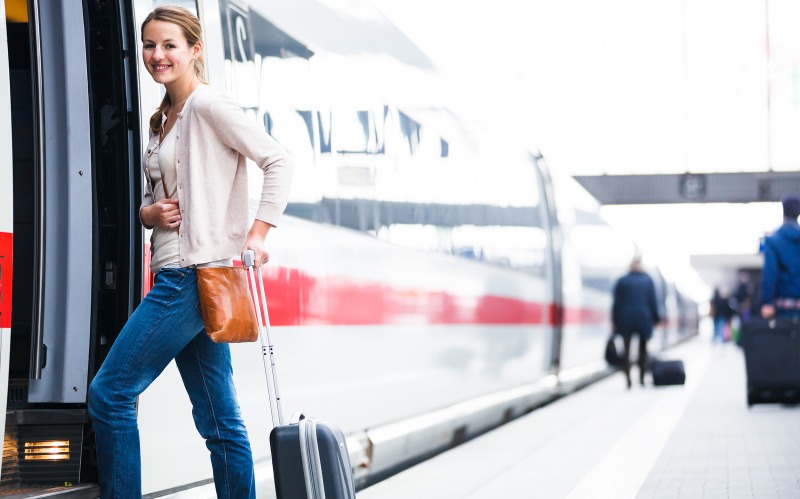There are seven steps for taking a train in China:
1. Get to the right station plenty of time ahead of departure
2. Have Your Passport/Travel Permit and E-Ticket Number Checked at the Entrance
3. Go Through the Security Check
4. Find the right waiting room
5. Check in
6. Find your train and seat
7. Get off the train and check out
What You Need to Board a Train in China:
Thanks to the widespread use of e-ticket services, passengers in China are not required to present paper tickets when boarding, provided they have been verified by China Railway. Only the passport/travel permit used for ticket purchase (or ID card, or Mainland Travel Permit for passengers from Hong Kong, Macau, and Taiwan) is needed for boarding the train.
See How to Book China Train Tickets.
Please see details of the seven steps:
1. Get to the Right Station.
It's crucial to pay attention to your departure station, especially since many cities in China have multiple train stations. For instance, Beijing has seven stations: Beijing Railway Station, Beijing Nan (South), Beijing Xi (West), Beijing Bei (North), Beijing Fengtai, Beijing Chaoyang, Qinghe, and Daxing Airport. Make sure to verify and head to the correct station for your departure.
For trains with the e-ticket service, please read your confirmation voucher carefully for the details - the train station, date, and departure time.
To ensure a smooth departure, it is advisable to arrive at the station well in advance of your scheduled train departure. We recommend arriving at least 1½ hours ahead of time to accommodate the security check process and allow sufficient time for queuing to board the train.
If you take a taxi to a train station, you can just show your ticket/confirmation voucher to the driver and give him this Chinese phrase printed on a piece of card.
- Chinese: 请送我到这个火车站. Qǐng sòng wǒ dào zhège huǒchēzhàn.
- English: Please drive me to this railway station.

2. Have Your Passport/Travel Permit and Ticket Checked at the Entrance
Upon arriving at the correct train station, you'll undergo a passport/permit and ticket check at the entrance before the security check. Most foreign passengers typically go through the manual entrance check to enter the station building. The automatic machine check is reserved for passengers holding Chinese ID cards, travel permits for Taiwan, Hong Kong, or Macau, or foreign permanent resident identity cards.
Simply present the passport/travel permit used for ticket purchase. A staff member will then scan your passport or input your passport number to verify the validity of your e-ticket for the specified day.
3. Go Through the Security Check
Upon arrival at the designated train station, a security check is mandatory before entering the waiting hall, and at some stations, it may even occur before entering the station building. Follow the same procedures as you would at an airport:
- Line up for the security check.
- Place your luggage, including handbags, hip pouches, and carry-on bags, on the security scanner conveyor belt.
- Walk through the metal detector gate.
- Stand still for the staff member to use a scanner on you and check for forbidden articles on your person.
Unlike the security restrictions at an airport, you can take water on a train. If you want to know more information about luggage on the train, please click baggage allowance details.
Please note: Keep your luggage and bags close to you and carry your valuables safe as there are many pickpockets at train stations.

4. Find the Right Waiting Room
After the security check, you will find a LED screen showing which train is allocated to which waiting room. There is usually Chinese only on the screen, please see the table below for translation help:
| Chinese | 车次 | 终到站 | 发车时间 | 候车室 | 状态 |
|---|---|---|---|---|---|
| English | Train | To | Departs at | Waiting room | State |
| e.g. | D5195 | 成都东 | 17:57 | 5 | 正在候车 (waiting) |

You can also ask a member of staff to help you find the right waiting room. Here is a Chinese phrase that might be helpful:
- Chinese: 请问我应该去哪个候车室? Qǐngwèn, wǒ yīnggāi qù nǎge hòuchēshì?
- English: Excuse me. Could you tell me which waiting room I should go to?

5. Check In to Board Through the Platform
There are several platform access gates in the waiting room. Just find the LED screen or card with your train number on it. You can also see the train status on the LED screen, in Chinese only.
How to check in with an e-ticket: Please present the passport/travel permit you used to buy the ticket at the manual ticket check. Staff members need to check it manually.
Usually check-in starts 15-30 minutes before departure. Barriers close 5 minutes before departure. If you collected the paper ticket, don't lose it or throw it away as you will need to show your ticket again at the exit of the station.

After your ticket has been checked, check the LED screen or follow everyone else entering through your ticket gate to find your platform. In some circumstances, you may need to walk up and down some stairs to get onto the platform.
In certain recently built or renovated stations, the walk to the platform is facilitated by escalators and elevators. However, not all train stations are equipped with escalators or elevators. In stations lacking these amenities, you may need to navigate stairs to access the platform.
Unlike in Europe, train boarding platforms in China typically do not have gates. When traveling with children, it's essential to keep a close eye on them, especially considering the large crowds. Be aware that there may be instances of pushing and shoving, so exercising caution and ensuring the safety of your companions is important.
On a platform, there might be trains on both sides. It's crucial to board the train with the number that corresponds to your train ticket. Ticket inspectors positioned by the doors of various coaches may request a ticket check, specifically the e-ticket number, but generally not an ID check. If you have any doubts about whether it's the right train, it's advisable to double-check with the inspector to ensure you are boarding the correct one.
6. Find Your Train and Seat
When you are boarding your train, show your e-ticket information to a staff member and make sure you are boarding the right train.

After getting on the train, you can find your seat/bunk according to your ticket. Put your baggage on the rack overhead or under your seat/berth. On high-speed trains, luggage can also be put in the special luggage space at the junction point between carriages.
During the journey, your e-ticket or passport might be checked by the train staff. When you exit the destination train station, your passport will be checked one more time.
Once aboard a sleeper train, the train attendants will provide you with a plastic bunk card to ensure you remember to disembark. This card serves as a reminder. Approximately 30 minutes before reaching your destination, the train attendants will collect the plastic card from you.

7. Get Off the Train and Check Out
Pay attention to the announcements about the arriving station. Announcements on most of the trains are in Chinese only. Bilingual announcements are available on some of the high-speed trains. If you need to get off at an intermediate station, it is advisable to remember your arrival time. You can also ask the conductor or other passengers to remind you. Here is a sentence that might be helpful:
- Chinese: 你好,请你在还有10分钟到这个站的时候告诉我一声,谢谢!
- English:Excuse me, please notify me 10 minutes before the train gets to this station (show your ticket), thank you.
If you need to transfer to another train: You don't need to get out of the station and re-enter if you transfer for a train at the same station. Follow the signs and LED screen and you will find the waiting room for your connecting train directly.

Follow the crowd or the signs at the station (usually only in Chinese) and you will get to the correct exit (出站口). You may need to carry your luggage to be able to negotiate long staircases to reach the exit.
Check out at the exit: When exiting the station, a check-out process will take place. Please ensure that you have your passport easily accessible as it will be inspected once again either by a staff member or a machine at the exit gate.

There are Red Hat Porters at some train stations, to help passengers carry luggage to and from the station. The price is about RMB10 per piece of luggage (the price may vary for different train stations).

City Transportation From a Train Station
You can find transportation signs for taxi/bus/subway easily around the station. Usually the operating time of buses and subway is from 05:00 to 23:00. Taxies are available 24 hours a day. But in large cities such as Beijing, Shanghai, Guangzhou and Xi'an, you might need to wait in long queues for taxis, especially during rush hour. Buses and subways are always crowed.
China Highlights' door-to-door private service can help you skip the queues and crowds. You will be transferred in a private van, making your trip comfortable and hassle-free. Book the transfer with us now.
Useful Chinese Sentences
Show the following sentences to members of staff at the station if you need help:
| Chinese | English |
|---|---|
| 请送我到这个火车站. Qǐng sòng wǒ dào zhège huǒchēzhàn. |
Please drive me to this train station. |
| 请问,火车售票处在哪里? Qǐngwèn, huǒchē shòupiàochù zài nǎlǐ? |
Excuse me, where is the ticket counter? |
| 请问,这个火车站站在哪里? Qǐng wèn, zhège huǒchēzhàn zài nǎlǐ? | Excuse me, where is this train station? |
| 请问,在哪个窗口办理退票? Qǐngwèn, zài nǎge chuāngkǒu bànlǐ tuìpiào? |
Excuse me, which counter is for canceling/refunding tickets? |
| 请问,在哪个窗口办理改签? Qǐngwèn, zài nǎge chuāngkǒu bànlǐ gǎiqiān? |
Which counter is for altering tickets? |
| 请问,洗手间在哪里? Qǐngwèn, xǐshǒujiān zài nǎlǐ? |
Where is the restroom, please? |
| 请问,这附近有餐厅吗? Qǐngwèn, zhè fùjìn yǒu cāntīng ma? |
Excuse me, is there a restaurant nearby? |
| 请问,寄存处在哪里? Qǐngxwèn, jìcúnchù zài nǎlǐ? |
Excuse me, where is the left luggage room? |
| 请问,我应该去哪个候车室? Qǐngwèn, wǒ yīnggāi qù nǎge hòuchēshì? |
Would you please tell me where my waiting room is? |


 (10,000+ reviews)
(10,000+ reviews)